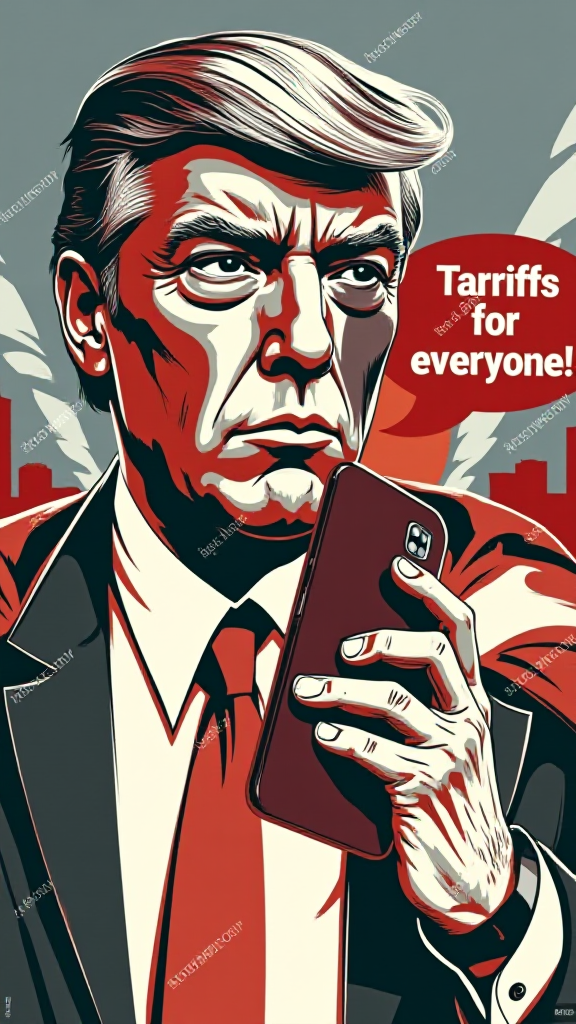US Tariffs: Can Apple Manufacture in the US?

The U.S. government’s aggressive tariff policies under President Trump have thrust Apple into a high-stakes experiment: reshoring manufacturing to counter China’s dominance in tech supply chains. The question is no longer whether Apple can manufacture in the U.S., but at what cost and with what impact on its global competitiveness.
The Tariff Landscape: A Double-Edged Sword
In April 2025, the U.S. imposed reciprocal tariffs of 145% on Chinese imports, but exempted critical electronics like smartphones, computers, and semiconductors. This carve-out, paired with a 90-day tariff suspension on most countries (except China), aimed to buy time for companies to transition production. However, the administration’s rhetoric remains contradictory: while urging firms to “onshore” manufacturing “as soon as possible,” it also threatened 25%+ tariffs on semiconductors—a threat later withdrawn after exemptions were formalized.
Apple’s $500 Billion Gamble
Apple’s February 2025 announcement of a $500 billion investment in U.S. manufacturing is its boldest move yet to navigate this landscape. Key components include:
- A 250,000-square-foot server plant in Houston, producing AI infrastructure for Apple Intelligence.
- A $10 billion expansion of its Advanced Manufacturing Fund, with TSMC’s Arizona chip facility as its linchpin.
- Hiring 20,000 U.S. workers in R&D and silicon engineering.
Apple’s stock surged 2% in April 2025 after tariff exemptions were announced, but remains 25% below its peak since Trump’s 2025 inauguration, reflecting investor skepticism about the cost of reshoring.
The Cost Conundrum: Where the Rubicon Lies
Analysts highlight staggering hurdles. Wedbush’s Dan Ives estimates that shifting 10% of Apple’s supply chain to the U.S. would cost $30 billion and take three years—while a fully U.S.-made iPhone could cost $3,500, triple its current price. These projections stem from:
1. Supply Chain Complexity: Apple relies on Taiwan for chips, South Korea for screens, and China for 90% of iPhone assembly. Replicating this ecosystem domestically is logistically and economically daunting.
2. Labor and Infrastructure Costs: U.S. manufacturing wages are 3-5x higher than in China, while energy and logistics costs add further strain.
3. Tariff Risks: While semiconductors are exempt for now, “National Security Tariff Investigations” loom, threatening future levies on Apple’s Chinese-assembled products.

The Political-Economic Tightrope
The Trump administration frames reshoring as a “national security imperative,” but economic realities complicate this narrative. Apple’s $500 billion pledge includes:
- $19 billion in 2024 U.S. taxes, part of a $75 billion five-year total, signaling fiscal commitment.
- Over 2.9 million U.S. jobs supported directly and indirectly, including via its app economy.
Yet, the Houston plant’s servers will initially supplement—not replace—overseas production. TSMC’s Arizona facility, while a milestone, produces only 10% of Apple’s chip needs. Meanwhile, India and Brazil—Apple’s diversification partners—face hurdles like 26% tariffs and underdeveloped supply chains.
Data-Driven Uncertainty
- China: $200–$300 per unit (including assembly and logistics).
- U.S.: $500–$700 per unit (pre-tariff), rising to $800–$1,000 if tariffs on components are applied.
Rosenblatt Securities warns that passing 30–43% cost increases to consumers could slash iPhone demand by 30%. Conversely, the CHIPS Act’s subsidies and Apple’s scale might offset some costs over time.
Conclusion: A Feasible, but Fragile, Future
Apple’s reshoring push is technically feasible but economically precarious. The $500 billion investment solidifies U.S. manufacturing leadership in AI and semiconductors, aligning with geopolitical goals. However, the $30 billion price tag for a 10% shift underscores that full reshoring is unrealistic without subsidy-heavy policies or a collapse of Asian supply chains.
Investors must weigh two scenarios:
1. Best Case: Gradual cost reductions via automation (e.g., Houston’s robotic facilities) and bipartisan support for the CHIPS Act. Apple’s stock could rebound if tariffs stabilize and U.S. production meets 15–20% of demand by 2030.
2. Worst Case: Rising costs force price hikes, eroding Apple’s market share. A 30% iPhone price increase would likely reduce unit sales by 20–25%, offsetting margin gains.
For now, Apple’s dual-track strategy—investing in U.S. tech while hedging in India and Brazil—buffers risk. Yet, the ultimate test lies in whether policymakers can bridge the gap between protectionism and economic pragmatism. As the Houston servers begin rolling off assembly lines, the world watches to see if patriotism can outpace profit.











